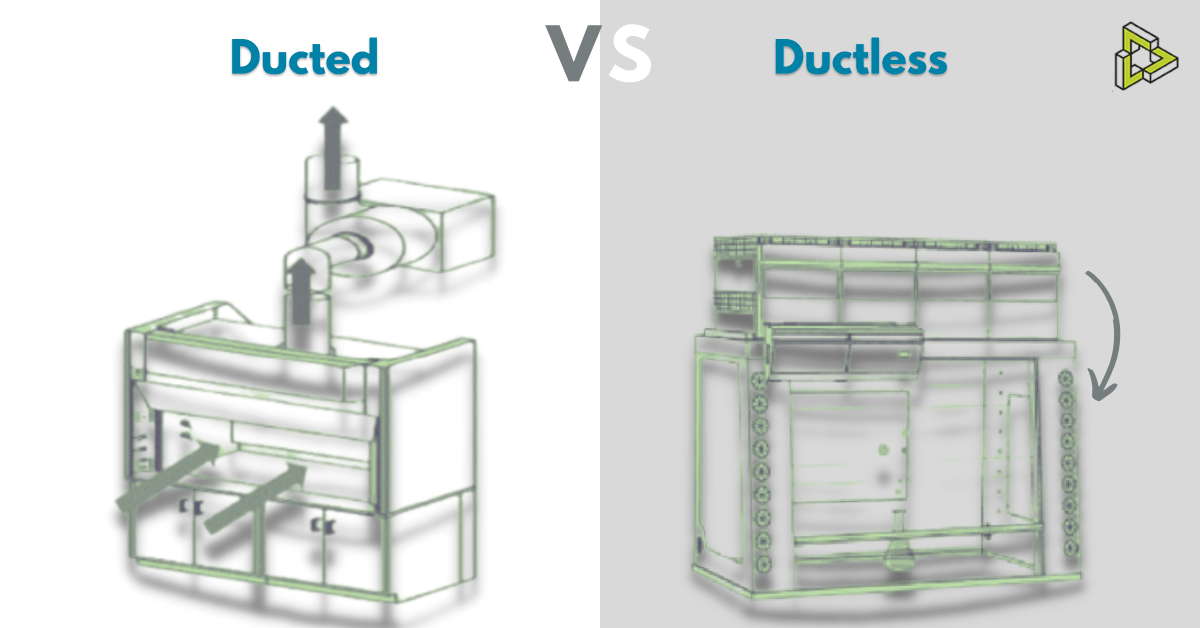To begin with, let’s refresh the difference between the two types of fume hoods. A ducted fume hood has the contaminants collected and thrown out of the lab area through ductwork, a blower, and maybe a scrubber. That means it releases contaminants outside of the lab building. On the other hand, a ductless fume hood (also called recirculating hood) collects the contaminants, filters them through a chemical filter, and releases the clean air into the same lab space. Both are a major part of the ventilation strategy that ensures clean air in the lab space. Both offer relative advantages and challenges. With time ductless hood technology has evolved. Hence the need for careful selection.
Here are 5 tips to help with your selection process:
1. Application
The starting point is the application or specific use assigned to a particular fume hood. A modern lab is expected to have several hoods. The experimentation needs for each hood may vary. Some might require more room for larger setups, some need to be walk-in types or some might need extra width. There may be requirements for handling perchloric acid or explosion-proof fittings. Secondly, the types of reactions that are assigned to a particular hood may be routine or special. The chemicals used may be known or may have newer agents. A ducted hood offers the flexibility to address all these challenges. The selection is relatively easier.
Ductless hoods on the other hand must be selected with due care. They have activated carbon filters which are coated with different chemical filters that clean a set of chemicals. Routine and slightly challenging experimentation can be assigned to ductless hoods, after a thorough evaluation. We do have several sizes (smaller sizes available) and various services fittings available in ductless hoods too. These hoods could offer a 360-degree view of the setup, which is a distinct advantage. Modern chemical filters address most requirements. However, for the specificity of experimentation, it is best to use a ducted hood. A ductless hood might not replace a ducted hood unless the due technical assessment is done.
2. Portability
It is common to experience the challenges offered by the constrained lab spaces, changes over time in the layout, flexibility needs of a particular research group, etc. A ducted hood is a very rigid piece of equipment owing to its bulkiness and fixed ductwork. Ductless hoods are easily portable. They can come with castors too. It is possible to repurpose a ductless hood by changing the chemical filter.
When adding extra hoods to the existing lab, the portability and flexibility offered by ductless hoods offer a great advantage.
3. Energy Expenditure/ Running Costs
Here ductless hood is a clear winner. Because of the ductwork and blower etc., a ducted hood consumes a lot more energy. On top of that, it needs almost the same quantity of makeup air to be supplied to the lab space. If the lab is air conditioned a lot of good-tempered air gets thrown out along with the contaminants. This puts a burden on the HVAC system. To a great extent, this problem is mitigated by using VAV hoods. However, a ducted hood remains an energy guzzler. On the contrary, a ductless hood filters air and recirculates the clean air back to the same space. It consumes much less energy and puts virtually no burden on the HVAC system.
The maintenance needs of a ducted fume hood consume time and it is always a challenge to service ducted hoods with minimum downtime. On the other hand, ductless hoods are easy to service, and maintenance costs are also less.
4. Safety
Some concerns about the safety offered by ductless hoods are important to be addressed. It is commonly believed that ducted fume hoods offer the highest safety as the contaminants are thrown out of the lab building. There is virtually no leakage or circulation of contaminants in the lab space. When in doubt, it is best to use a ducted hood.
A ductless hood depends on its chemical filters to clean the air. They essentially have an activated carbon filter to filter most smells and organic matter. For other sets of chemicals, these filters are coated with filtering reagents. It is very important to get the application technically audited and the right filter used. One must avoid using a ductless hood for non-compatible and unknown chemicals. We at Labguard, use the latest technology from Erlab, France (the world leader in ductless hood technology) to address application-specific challenges. Once a proper technical audit is done and a specific filter is determined, ductless hoods offer the same standard of safety.
A ductless hood chemical filter gets saturated over time and needs replacement. There is an alarm provided to know when the filter is due for replacement. Compromising the replacement of a saturated filter is equal to compromising the overall lab safety. We at Labguard, are equipped to handhold the users with filter life and replacement concerns.
5. Environmental Concerns
A ducted fume hood does consume a lot of fossil-generated energy (electricity) and adds to the overall carbon footprint of your laboratory. Moreover, it burdens the HVAC where higher sizing is needed and the lab consumes still more energy.
The energy consumed by a ductless hood is much less, say just 30% of the ducted hood. So, if environmental concerns are paramount, each fume hood must be carefully selected. A ductless hood will offer much less energy consumption and win precious carbon credits for your lab.
Disposal of used filters for a ductless hood can pose some challenges and we at Labgurad will help you overcome those.
In conclusion, we can say that it is better to introduce ductless hoods to realize many relative advantages. A word of caution though is conducting a thorough analysis of your applications with our support. Going ductless, wherever possible is the best way forward.


